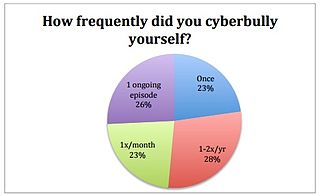Gender dysphoria (GD) is the distress a person experiences due to a mismatch between their gender identity—their personal sense of their own gender—and their sex assigned at birth. The diagnostic label gender identity disorder (GID) was used until 2013 with the release of the diagnostic manual DSM-5. The condition was renamed to remove the stigma associated with the term disorder.

The World Psychiatric Association is an international umbrella organisation of psychiatric societies.
Gender dysphoria in children (GD), also known as gender incongruence of childhood, is a formal diagnosis for children who experience significant discontent due to a mismatch between their assigned sex and gender identity. The diagnostic label gender identity disorder in children (GIDC) was used by the Diagnostic and Statistical Manual of Mental Disorders (DSM) until it was renamed gender dysphoria in children in 2013 with the release of the DSM-5. The diagnosis was renamed to remove the stigma associated with the term disorder.

The National Institute of Mental Health and Neuro-Sciences is a medical institution in Bangalore, India. NIMHANS is the apex centre for mental health and neuroscience education in the country. It is an Institute of National Importance operates autonomously under the Ministry of Health and Family Welfare. NIMHANS is ranked 4th best medical institute in India, in the current National Institutional Ranking Framework.
Adolescent medicine also known as adolescent and young adult medicine is a medical subspecialty that focuses on care of patients who are in the adolescent period of development. This period begins at puberty and lasts until growth has stopped, at which time adulthood begins. Typically, patients in this age range will be in the last years of middle school up until college graduation. In developed nations, the psychosocial period of adolescence is extended both by an earlier start, as the onset of puberty begins earlier, and a later end, as patients require more years of education or training before they reach economic independence from their parents.
Child psychotherapy, or mental health interventions for children refers to the psychological treatment of various mental disorders diagnosed in children and adolescents. The therapeutic techniques developed for younger age ranges specialize in prioritizing the relationship between the child and the therapist. The goal of maintaining positive therapist-client relationships is typically achieved using therapeutic conversations and can take place with the client alone, or through engagement with family members.
Child and adolescent psychiatry is a branch of psychiatry that focuses on the diagnosis, treatment, and prevention of mental disorders in children, adolescents, and their families. It investigates the biopsychosocial factors that influence the development and course of psychiatric disorders and treatment responses to various interventions. Child and adolescent psychiatrists primarily use psychotherapy and/or medication to treat mental disorders in the pediatric population.
Youth suicide is when a young person, generally categorized as someone below the legal age of majority, deliberately ends their own life. Rates of youth suicide and attempted youth suicide in Western societies and other countries are high. Youth suicide attempts are more common among girls, but adolescent males are the ones who usually carry out suicide. Suicide rates in youths have nearly tripled between the 1960s and 1980s. For example, in Australia suicide is second only to motor vehicle accidents as its leading cause of death for people aged 15–25.

Depression is a mental disorder characterized by prolonged unhappiness or irritability, accompanied by a constellation of somatic and cognitive signs and symptoms such as fatigue, apathy, sleep problems, loss of appetite, loss of engagement; low self-regard or worthlessness; difficulty concentrating or indecisiveness; or recurrent thoughts of death or suicide. Depression in childhood and adolescence is similar to adult major depressive disorder, although young sufferers may exhibit increased irritability or behavioral dyscontrol instead of the more common sad, empty, or hopeless feelings seen with adults. Children who are under stress, experiencing loss, or have other underlying disorders are at a higher risk for depression. Childhood depression is often comorbid with mental disorders outside of other mood disorders; most commonly anxiety disorder and conduct disorder. Depression also tends to run in families. In a 2016 Cochrane review cognitive behavior therapy (CBT), third wave CBT and interpersonal therapy demonstrated small positive benefits in the prevention of depression. Psychologists have developed different treatments to assist children and adolescents suffering from depression, though the legitimacy of the diagnosis of childhood depression as a psychiatric disorder, as well as the efficacy of various methods of assessment and treatment, remains controversial.
James Frederick Leckman, M.D., is a child psychiatrist and psychoanalyst and the Neison Harris Professor of Child Psychiatry, Psychiatry, Psychology and Pediatrics at the Yale School of Medicine, recognized for his research in Tourette syndrome (TS) and obsessive–compulsive disorder (OCD).
Child and Adolescent Mental Health (CAMH) is a quarterly peer-reviewed medical journal published by Wiley-Blackwell in Britain on behalf of the Association for Child and Adolescent Mental Health. The journal publishes peer-refereed child and adolescent mental health services research relevant to academics, clinicians and commissioners internationally. CAMH publishes reviews, original articles, and pilot reports of innovative approaches, interventions, clinical methods and service developments. The journal has regular sections on Measurement Issues, Innovations in Practice, Global Child Mental Health and Humanities.

The International Association for Child and Adolescent Psychiatry and Allied Professions (IACAPAP) is a non-governmental international association that advocates for the "promotion of the mental health and development of children and adolescents through policy, practice and research". Its membership is mainly Latin and North American, European, and Pacific Rim-based.
Indian Association of Clinical Psychologists (IACP) is the national association of clinical psychologists in India. It was founded in 1968. As of 2019, the President of the association is Dr. Kalpana Srivastava. IACP publishes its flagship journal entitled Indian Journal of Clinical Psychology (IJCP). IACP confers following professional awards in clinical psychology:
- C S Kang Award for overall contributions in clinical psychology
- H N Murthy Award for contributions in behavioral medicine and bio-feedback
- Psycho-Oration for life time contribution in substance use disorder and mental health
- Child and adolescent award previously known as Asha Nigam award for work in child and adolescent mental health
- S C Gupta Best Paper for the best presentation in the NACIACP scientific sessions
- Young Scientist award who has done a commendable research work
- Forensic Psychology Award
- Awards for best paper in each session of its National Annual Conference

Vikram Harshad Patel FMedSci is an Indian psychiatrist and researcher best known for his work on child development and mental disability in low-resource settings. He is the Co-Founder and former Director of the Centre for Global Mental Health at the London School of Hygiene and Tropical Medicine (LSHTM), Co-Director of the Centre for Control of Chronic Conditions at the Public Health Foundation of India, and the Co-Founder of Sangath, an Indian NGO dedicated to research in the areas of child development, adolescent health and mental health. Since 2016 he has been Pershing Professor of Global Health and Social Medicine at the Department of Global Health and Social Medicine of Harvard Medical School in Boston. He was awarded a Wellcome Trust Principal Research Fellowship in 2015. In April 2015, he was listed as one of the world's 100 most influential people by TIME magazine.
The Journal of Clinical Child & Adolescent Psychology is a bimonthly peer-reviewed journal covering child and adolescent mental health. It was established in 1971 as the Journal of Clinical Child Psychology, obtaining its current name in 2001. It is published by Routledge on behalf of the American Psychological Association's Division 53, the Society of Clinical Child and Adolescent Psychology. The editor-in-chief is Andres De Los Reyes. According to the Journal Citation Reports, the journal has a 2017 impact factor of 5.014, ranking it sixth out of 127 journals in the category "Psychology, Clinical". In 2017, the journal launched the "Future Directions Forum", an annual meeting held in Washington, DC, that profiles content published in the journal's "Future Directions" article series and provides professional development training to early career scientists.
Stan Kutcher is a Canadian Senator and Professor Emeritus of Psychiatry at Dalhousie University. He was appointed to the Senate of Canada on December 12, 2018.
The relationships between digital media use and mental health have been investigated by various researchers—predominantly psychologists, sociologists, anthropologists, and medical experts—especially since the mid-1990s, after the growth of the World Wide Web. A significant body of research has explored "overuse" phenomena, commonly known as "digital addictions", or "digital dependencies". These phenomena manifest differently in many societies and cultures. Some experts have investigated the benefits of moderate digital media use in various domains, including in mental health, and the treatment of mental health problems with novel technological solutions.

Auto-trolling, self-cyberbullying, digital Munchausen or digital self-harm is a form of self-abuse on the Internet. It is usually done by teenagers posting fake insults on social media, attacking themselves to elicit attention and sympathy. A study in 2012 found that about 35 per cent of those who did this felt better. Studies in 2016 and 2019 found an increase in prevalence in American adolescents rising from 6 to 9 per cent. In a 2011 study, boys were more likely than girls to admit to digital self-bullying. In a 2022 study published by researchers Justin Patchin, Sameer Hinduja, and Ryan Meldrum, US youth who engaged in digital self-harm were between five and seven times more likely to have considered suicide and between nine and fifteen times more likely to have attempted suicide.





